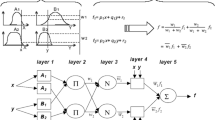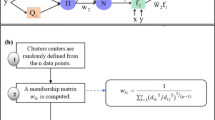Abstract
Fuzzy logic is, inter alia, a simple and flexible approach of modelling that can be used in river basins where adequate hydrological data are unavailable. In order to improve the real-time forecasting of floods, this paper proposes a Takagi–Sugeno fuzzy inference system termed as flood model Sugeno. A total of 12 input parameters were used to develop two fuzzy flood models—Mamdani and Sugeno. Whereas Sugeno FIS performed exceptionally well in predicting the river discharge, the Mamdani FIS failed to deliver the accurate results. The river Jhelum flowing through the Kashmir Valley in the northern Himalayas, India, was hit in September 2014 by a major flood and has been chosen as the case study to apply the fuzzy flood models. With a total of 24 rules in the rule base and five levels of linguistic variables, the flood model Sugeno predicted the river discharge with Nash–Sutcliffe model efficiency of 0.887, coefficient of correlation (R2) of 90.74%, mean square error of 0.00122, root mean square error of 0.0349, mean absolute error of 0.0139 and combined accuracy of 0.0466. The efficiencies of the developed model show acceptable levels according to the tested performance indicators implying the potential of establishing a flood forecasting system using the developed model.








Similar content being viewed by others
References
Mosavi A, Ozturk P, Chau KW (2018) Flood prediction using machine learning models: literature review. Water (Switzerland) 10:1–40. https://doi.org/10.3390/w10111536
Jongman B, Wagemaker J, Romero BR, De Perez EC (2015) Early flood detection for rapid humanitarian response: harnessing near real-time satellite and Twitter signals. ISPRS Int J Geoinf 4:2246–2266. https://doi.org/10.3390/ijgi4042246
Baharom AS, Idris Z, Sarah S et al (2014) Prediction of flood detection system: fuzzy logic approach. Int J Enhanc Res Sci Technol Eng 3:335–339
Rafieeinasab A, Norouzi A, Kim S et al (2015) Toward high-resolution flash flood prediction in large urban areas—analysis of sensitivity to spatiotemporal resolution of rainfall input and hydrologic modeling. J Hydrol. https://doi.org/10.1016/j.jhydrol.2015.08.045
Yu W, Nakakita E, Jung K (2016) Flood forecast and early warning with high-resolution ensemble rainfall from numerical weather prediction model. Procedia Eng 154:498–503. https://doi.org/10.1016/j.proeng.2016.07.544
Suchkova KV, Motovilov YG (2019) Sensitivity assessment of a runoff formation model in the Mozhaisk reservoir river basin. Water Resour 46:S40–S50. https://doi.org/10.1134/S009780781908013X
Jayawardena AW, Perera EDP, Zhu B et al (2014) A comparative study of fuzzy logic systems approach for river discharge prediction. J Hydrol 514:85–101. https://doi.org/10.1016/j.jhydrol.2014.03.064
Sun W, Trevor B (2015) A comparison of fuzzy logic models for breakup forecasting of the Athabasca river. CGU HS Committee on River Ice Processes and the environment. Presented at the 18th workshop on the hydraulics of Ice Covered Rivers, Quebec City, QC, Canada, 18–21 August 2015. http://cripe.ca/docs/proceedings/18/25_Sun_Trevor_2015.pdf
Nandalal HK, Ratnayake UR (2011) Flood risk analysis using fuzzy models. J Flood Risk Manag 4:128–139. https://doi.org/10.1111/j.1753-318X.2011.01097.x
Zadeh LA (1965) Fuzzy sets. Inf Control 8:338–353
Kim B, Choi SY, Han KY (2019) Integrated real-time flood forecasting and inundation analysis in small–medium streams. Water (Switzerland) 11:1–19. https://doi.org/10.3390/w11050919
Shu C, Ouarda TBMJ (2008) Regional flood frequency analysis at ungauged sites using the adaptive neuro-fuzzy inference system. J Hydrol 349:31–43. https://doi.org/10.1016/j.jhydrol.2007.10.050
Wang Y, Hong H, Chen W et al (2019) Flood susceptibility mapping in Dingnan county (China) using adaptive neuro-fuzzy inference system with biogeography based optimization and imperialistic competitive algorithm. J Environ Manag 247:712–729. https://doi.org/10.1016/j.jenvman.2019.06.102
Dubois D, Esteva F, Godo L, Prade H (2007) Fuzzy-set based logics—a history-oriented presentation of their main developments. Handb Hist Log 8:1–128. https://doi.org/10.1016/S1874-5857(07)80009-4
Bhat MS, Alam A, Ahmad B et al (2019) Flood frequency analysis of river Jhelum in Kashmir basin. Quat Int 507:288–294. https://doi.org/10.1016/j.quaint.2018.09.039
Akhter M, Ahmad AM (2017) Environment pollution and climate change-climate modeling of Jhelum River basin—a comparative study. Environ Pollut Clim Change 1:1–14
Beniston M (2003) Climatic change in mountain regions: a review of possible impacts. Clim Change 59:5–31
Jain M, Parvaze S (2017) Hydrodynamic modelling of extreme flood events in the Kashmir valley in India. Geophys Res Abstr 19:12021
Bhutiyani MR, Kale VS, Pawar NJ (2010) Climate change and the precipitation variations in the northwestern Himalaya: 1866–2006. Int J Climatol 548:535–548. https://doi.org/10.1002/joc.1920
Arora M, Kumar N, Kumar R (2016) An analysis of causes and circumstances of extreme floods in Jhelum basin. J Indian Water Resour Soc 36:15–21
Rao GS, Farooq M, Sree M (2016) Satellite-based assessment of the catastrophic Jhelum floods of September 2014, Jammu & Kashmir, India. Geomat Nat Hazards Risk. https://doi.org/10.1080/19475705.2016.1218943
Saleh SF, Rather FF, Jabbar MJ (2017) Floods and mitigation techniques with reference to Kashmir. Int J Eng Sci Comput 7:6359–6363
Güçlü YS, Zekai S (2016) Hydrograph estimation with fuzzy chain model. J Hydrol 538:587–597. https://doi.org/10.1016/j.jhydrol.2016.04.057
Lohani AK, Goel NK, Bhatia KKS (2014) Improving real time flood forecasting using fuzzy inference system. J Hydrol 509:25–41. https://doi.org/10.1016/j.jhydrol.2013.11.021
Altunkaynak A, Özger M, Çakmakci M (2005) Water consumption prediction of Istanbul City by using fuzzy logic approach. Water Resour Manag 19:641–654. https://doi.org/10.1007/s11269-005-7371-1
Alvisi S, Mascellani G, Franchini M (2006) Water level forecasting through fuzzy logic and artificial neural network approaches. Hydrol Earth Syst Sci 10:1–17
Jacquin AP, Shamseldin AY (2006) Development of rainfall–runoff models using Takagi–Sugeno fuzzy inference systems. J Hydrol 329:154–173. https://doi.org/10.1016/j.jhydrol.2006.02.009
See L, Openshaw S (2000) A hybrid multi-model approach to river level forecasting. Hydrol Sci J 45:523–536. https://doi.org/10.1080/02626660009492354
Mahabir C, Hicks FE, Fayek AR (2003) Application of fuzzy logic to forecast seasonal runoff. Hydrol Process 17:3749–3762. https://doi.org/10.1002/hyp.1359
Kişi Ö (2004) Multi-layer perceptrons with Levenberg-Marquardt training algorithm for suspended sediment concentration prediction and estimation. Hydrol Sci J 49:1025–1040. https://doi.org/10.1623/hysj.49.6.1025.55720
Luchetta A, Manetti S (2003) A real time hydrological forecasting system using a fuzzy clustering approach. Comput Geosci 29:1111–1117. https://doi.org/10.1016/S0098-3004(03)00137-7
Foley M, Mcgrory J (2011) The application of fuzzy logic in determining linguistic rules and associative membership functions for the control of a manufacturing process. Dublin Institute of Technology, Dublin
Yildiz ZC (2010) A short fuzzy logic tutorial. Bilkent University, Turkey, pp 1–6. http://cs.bilkent.edu.tr/~zeynep/files/short_fuzzy_logic_tutorial.pdf
Romshoo SA, Altaf S, Rashid I et al (2018) Climatic, geomorphic and anthropogenic drivers of the 2014 extreme flooding in the Jhelum basin of Kashmir, India. Geomat Nat Hazards Risk. https://doi.org/10.1080/19475705.2017.1417332
Eptisa (2018) Jhelum and Tawi flood recovery Project-Part A. The World Bank Group, vol 1, pp 1–145. http://jtfrp.in/wp-content/uploads/2019/03/Task1_Report_Final.pdf
Rashetnias S (2016) Flood vulnerability assessment by applying a fuzzy logic method: a case study from Melbourne. Victoria University, Melbourne
Mekanik F, Imteaz MA, Talei A (2016) Seasonal rainfall forecasting by adaptive network-based fuzzy inference system (ANFIS) using large scale climate signals. Clim Dyn 46:3097–3111. https://doi.org/10.1007/s00382-015-2755-2
Nguyen P, Thorstensen A, Sorooshian S et al (2015) A high resolution coupled hydrologic–hydraulic model (HiResFlood-UCI) for flash flood modeling. J Hydrol. https://doi.org/10.1016/j.jhydrol.2015.10.047
Chapi K, Singh VP, Shirzadi A et al (2017) Environmental modelling & software: a novel hybrid artificial intelligence approach for flood susceptibility assessment. Environ Model Softw 95:229–245. https://doi.org/10.1016/j.envsoft.2017.06.012
Mamdani EH, Assilian S (1975) An experiment in linguistic synthesis with a fuzzy logic controller. Int J Man Mach Stud 7:1–13. https://doi.org/10.1016/S0020-7373(75)80002-2
Sugeno M (1985) An introductory survey of fuzzy control. Inf Sci (NY) 36:59–83. https://doi.org/10.1016/0020-0255(85)90026-X
Perera Edangodage Duminda, Pradeep Lahat L (2014) Fuzzy logic based flood forecasting model for the Kelantan river basin. J Hydroenviron Res. https://doi.org/10.1016/j.jher.2014.12.001
Tayfur G, Moramarco T, Singh VP (2007) Predicting and forecasting flow discharge at sites receiving significant lateral inflow. Hydrol Process. https://doi.org/10.1002/hyp.6320
Tareghian R, Kashefipour S (2007) Applications of fuzzy systems and artificial neural networks for flood forecasting. J Appl Sci 7:3451–3459
Nayak PC, Sudheer KP, Rangan DM, Ramasastri KS (2005) Short-term flood forecasting with a neuro-fuzzy model. Water Resour Res 41:1–16. https://doi.org/10.1029/2004WR003562
Acknowledgements
The authors acknowledge the financial support rendered by the Ministry of Human Resources and Development, India, for carrying out the research.
Author information
Authors and Affiliations
Corresponding author
Ethics declarations
Conflict of interest
The authors declare that they have no conflict of interest.
Additional information
Publisher's Note
Springer Nature remains neutral with regard to jurisdictional claims in published maps and institutional affiliations.
Rights and permissions
About this article
Cite this article
Tabbussum, R., Dar, A.Q. Comparison of fuzzy inference algorithms for stream flow prediction. Neural Comput & Applic 33, 1643–1653 (2021). https://doi.org/10.1007/s00521-020-05098-w
Received:
Accepted:
Published:
Issue Date:
DOI: https://doi.org/10.1007/s00521-020-05098-w




